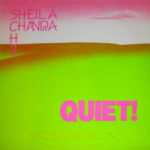
It still boggles my mind that Quiet! was in fact crafted by the same artist who sang in the proto-Asian Underground hit “Ever So Lonely“. A severe departure from the proto-Asian Underground Pop she’s known for, Quiet! showed Sheila Chandra working untethered, trying to go beyond the Orientalism of her past work and push it forward in directions that weren’t entirely clear (even to her). There are no lyrics in Quiet! There are no dance, funk, or easy to pick out grooves either. There aren’t any things that directly scream “Indian” either. What you hear in Quiet! is Sheila taking her vocal technique and musical knowledge to a new precipice. It’s a mixture that skirts the line of ambient, drone, minimal, and devotional music with western and eastern instruments moving in decidedly different ways. Yet, Quiet! in spite of being her most experimental (and lesser known) work, somehow, sounds the most timeless and engrossing. Beautiful, meditative, and truly unpredictable, in ways that belie her notoriety, Quiet! paints the picture of an artist who knew she had more to offer than whatever the industry expected her to do.

Sheila Chandra was just sixteen years old when prog journeyman Steve Coe plucked this young British-Indian teen actress, more known for her role on Grange Hill, to be the voice, focus, and muse of his group Monsoon. Under Monsoon, Sheila Chandra’s raga-inflecting vocals would provide a certain degree of authenticity to what amounted to a whole bunch of British guys’ attempting to create Indian-influenced Western pop music. After releasing their one and only album Third Eye, Monsoon, as a group, realized that they were skirting the line of Orientalism a bit too closely. Unwilling to fully embrace the kitschy image their label wanted to push, Monsoon dissolved as a group and resolved to promote Sheila as a solo artist on the indie label they’d create and dub ‘Indipop’ and help her create music (behind the scenes).
What you hear in Quiet! is a corrective. Her solo debut, released mere months earlier, On My Own, found her struggling to find her footing on her own. Half Monsoon-like and half-hearted in this new territory she was more interested in exploring, the recording sessions of Quiet! exposed how important it was for Sheila to stake out her own musical ideas and ground. To start on a clean slate, Sheila had to throw off the image audiences expected from her as a British-Indian woman. Sheila had to force herself out of her comfort zone by using traditional Indian dance vocal techniques with music that purposely avoided overt grooves, choosing instead to create undulating, floating, microtonal music.
Featuring countless vocal overdubs, trance-inducing melodies, and nary a drum beat (unless produced by Sheila’s own breath), Quiet! strikes something closer to the original idea behind Monsoon’s creation and Sheila Chandra’s own musical awakening. Deeply hypnotic and unexpected, Quiet! still displays the boundless imagination Sheila gas when given the correct platform to follow her own muse.
I did not take on board the contemporary short term view around me in 1984 that I thought to be producing slick, trendy product out of the already well trodden paths and over-refined resources of the pop world (both artistically and in the business sense) to help throw off the hopelessly kitsch, invalidated image of the Asian community constructed by the media at the time in Britain. I could see only artistic insecurity in that direction.
Instead, the premise from which the team of writers worked on the album reflected my wish to abandon any known, sure-fire element so that more obscure methods, structures, and elements would have to be explored and, to some degree, quantified. Consequently, it was decided that Quiet would be lyricless, the tracks untitled, and, rather than draw on any predictable or trendy connotated musical form, such as cool jazz or funk as a constant prop in its equation, that the album would explore the structural world as cyclic riffs, combined with as many tones and textures (out of the vast array possible both Oriental and Occidental) as I could vocally bring to the work. My aim was not produce a well-honed product, or to polish what we knew, but to force myself particularly, into the kind of new territory where I could learn as a musician and writer; in other words to sacrifice this album as a product to the long term goal of my growth as an artist.
“For the first time as a writer, I was facing the ‘blank page’ – the potentially most powerful reflector of the human soul. I was terrified at the necessity of committing to paper or vinyl was I really thought or felt musically – I still am sometimes – I insisted I ‘didn’t want to’ write, that I ‘couldn’t write’, – even when I came up with the three beautiful melodies at my first attempt for (appropriately enough) “Quiet 1.” I have since grown to deeply value the mental freedoms possible in the pure world of imagination that writing led me into, and its effect on my personal development. In it, I cannot be limited by any social, cultural or material restriction. I can think thoughts I was perhaps never meant to think. Quiet is the album where that process began.”Sheila Chandra, from liner notes to Quiet!
